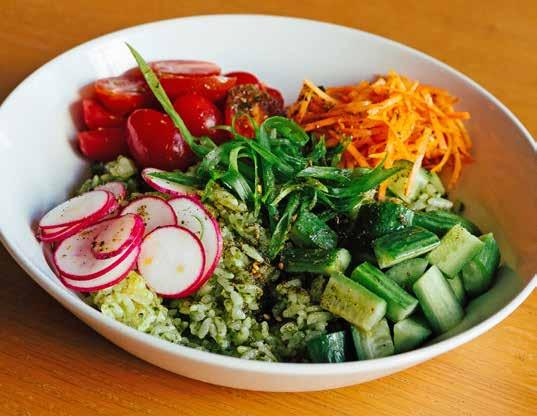
11 minute read
Chefs’ Tips and Tricks
Making the Most of the Harvest
BY KEANE STRAUB I PHOTOGRAPHY BY DONG KIM O ne of the best ways to take in the sights, the smells, and the tastes at this time of year is to head to local farmers markets. Alberta farmers grow amazing produce from blue oyster mushrooms, to bok choy, to sea buckthorn, and everything in between. And, as more local restaurants are using locally sourced ingredients, we
Advertisement
Albertans have the advantage of being able to discover new things with every meal, while supporting local restaurants and farmers. It’s a great feeling, especially at such a bountiful time of year.
Even though we’re maybe not dining out as much these days, we can still find ways to make new discoveries in our kitchens at home. This month we talked to four
Alberta chefs about sourcing ingredients right here in Alberta, namely veggies (and fruit!), and how to incorporate them into a main dish.
Say goodbye to veggies at the side of the plate; these greens – and bright oranges, and Brown Butter, combining crispy Mans Organic Cantaloupe and vibrant reds, and mellow yellows – are potatoes, and an addictive brown butter with Oolong and Lime the main attraction. sauce. When Fogo Island Fishery in Serves 4-6 Newfoundland stepped in and added the snow crab, King says it “took the dish to 1 medium-sized cantaloupe another level.” 1/3 cup plus 1 Tbs (100 mL) water Now, we can’t all get Fogo Island crab, 1 Tbs sugar but we can still find plenty of local goodies 1 stalk lemongrass, chopped, white part to incorporate into our home cooking. only King is big on research, and points out that 1 Kefir lime leaf or the zest of one lime every farmer’s market in Alberta has an 1 lime, juiced updated list of vendors on their websites. 1 bag Oolong tea And, most importantly, talk to the vendors 1 cup (250 mL) water about their farming practices and what Crushed ice they specialize in. “Once you’ve found a farm that has 1. Using a serrated knife, remove the beautiful baby leeks or cauliflower, hit skin from the cantaloupe and portion into
While the menu can change depending the internet and become inspired with wedges, removing seeds and membrane. on the availability of an ingredient, or the techniques and recipe ideas,” he suggests. 2. Place water, sugar, lemongrass, and kitchen staff needing to shake things up, It was King’s discovery of the melons lime leaf or zest into a small saucepan Bar Von der Fels, in Calgary, has one goal from Mans Organics – based in Coaldale, and bring to a boil. Remove from heat according to Chef Douglas King. “We Alberta, and available at Blush Lane and add lime juice. Chill. want our guests to leave the restaurant Organics in the Calgary Farmer’s Market 3. Brew one serving of Oolong tea and feeling like they’ve had an experience that – that inspired this refreshing take on chill. can’t be recreated at home.” cantaloupe with a chilled spritz of Oolong 4.Add lime mixture to tea and brush
The constant on the menu is the tea served at the start of a meal. Who says over melon slices. Serve on a bed of Hasselback Potatoes, Fogo Island Crab, fruit is just for smoothies? crushed ice.

Newly opened in April 2020, Edmonton’s Rosewood Foods aims to bring comfort and nostalgia to the downtown community. As Chef Noah Gado explains, the menu draws inspiration from several cultural influences and global experiences.
His time spent working and living in Melbourne exposed him to a vast array of cultural cuisines and atypical ingredients. This led to Gado developing what he calls an informal style of cooking, allowing him to “combine seasonal ingredients with past experiences to create a finished dish.”
Fresh, local, seasonal ingredients are the highlights of Rosewood’s menu, Gado explains, and using them supports local Alberta farms. “I find the best way to discover good products and to learn about the producers is by being curious. If something catches my eye, I start a dialogue with the vendor about what they suggest is best for its application or what may be available in the coming weeks.”
Gado describes Rosewood’s Verde Rice Bowl as a market-driven, westcoast inspired dish. It’s completely versatile, which allows you to incorporate seasonal vegetables and herbs from your favourite vendor market – try Gull Valley Greenhouse at Edmonton’s Callingwood Farmers’s Market – or your own backyard garden. And, because it’s adaptable, it can be served for any meal of the day, any day of the week.


Rosewood Verde Bowl Serves 4-6
3 cups medium grain rice, cooked according to package instructions 3 Tbs (45 mL) neutral oil
Verde sauce 2 cups mixed herbs, being mindful of each herb’s strength, eg. parsley, oregano, dill, mint, chives, scallion, basil, or cilantro ½ cup (120 mL) red wine vinegar 1 Tbs (15 mL) local maple syrup or local honey 2 cloves of garlic 1 Tbs salt, add more to taste ½ cup (120 mL) neutral oil like canola ½ cup (120 mL) olive oil 2 Tbs (30 mL) lemon juice to taste To taste salt
Toppings Choose your favourite vegetables from the farmers market and cut to bite-sized pieces. Rosewood use cherry tomatoes, cucumbers, pickled carrots, radish and house made chili oil. Feel free to top it with an egg, a nice local sausage or bacon. 1. Rinse the rice. Using a pot or a rice

cooker, cook the rice according to package instructions until just done, let cool. 2. Chop herbs into rough pieces. Place them in a blender with the vinegar, maple syrup/honey, garlic and salt. Start to blend while pouring in oil at a slow stream. Once smooth, check for balance of sweetness, saltiness, and acidity to your preference. 3. Heat a non-stick frying pan on medium heat. Add oil and then 1-2 cups of the cooked rice, depending on the size of the pan (it’s important not to crowd the pan). Flatten the rice with a spatula and fry without stirring until golden brown. Warm the rice through then put into a bowl. Repeat this method for the remainder of rice. 4.Add verde sauce ¼ cup (60 mL) at a time proportionate to the amount of rice. Continue tasting and mixing. The rice should be a deep green colour but not too loose or wet. Finish by seasoning with lemon juice and salt to your taste. It should be very vibrant and strongly seasoned to contrast with the freshness of your toppings. 5. Place the rice in the bottom of a platter or bowl, then arrange your toppings on top and serve.


For Chef Alex Hamilton, the Allium Restaurant in Calgary’s Beltline is firstly a great restaurant serving well thoughtout food and cocktails, and vegetarian restaurant second.
“We want (guests) to know that this place will satisfy most diners whether vegan, vegetarian or omnivore,” he says.
Dishes such as Bok Choy Caesar Salad are a customer fave, swapping classic romaine for refreshing bok choy from The Basil Ranch in Calgary. The Pickled Fried Mushrooms are just that: plump, local mushrooms are pickled, then fried, and served with miso gravy, nasturtium and chili oil.
As for going local in your own kitchens, Hamilton says research is key, and urges people to be curious, and learn about the local food supply chain. He says oftentimes some of the best native produce is overlooked because something else is mainstream and ‘hyped up’ – and more often than not, it isn’t local. “The more educated the public is, the more diverse the produce will be.”
Hamilton also insists that the in-home kitchen is the perfect place to experiment. “Nobody is paying money so there is room to make errors, and errors lead to new discoveries,” he says.
If you’re feeling adventurous, and you’re itching to fire up the grill for one last go this season, try Hamilton’s recipe for barbecued lion’s mane mushrooms, which uses this unique and aptly named fungi, available at Alberta’s Red Fox Fungi in cSpace Farmers Market in Marda Loop. BBQ Lion’s Mane Mushroom with Charred Brassica Slaw Serves 4
3 large lion’s mane mushrooms 2 Tbs (30 mL) neutral oil 2 Tbs steak spice ½ cup (120 mL) BBQ sauce To taste salt and pepper
Slaw ½ head of broccoli, cut in half ½ head romanesco, cut in half 4 radishes, sliced thinly 1 kohlrabi, peeled and cut into small julienned sticks 2 heads baby or Shanghai bok choy 3 green onions, thinly sliced 2 Tbs (30 mL) cold pressed canola oil To taste salt and pepper
Dressing 3 Tbs (45 mL) apple cider vinegar 2 Tbs chopped dill 2 Tbs chopped Italian parsley 2 Tbs (30 mL) brassica mustard 1 Tbs garlic powder To taste salt and pepper

1. Turn on BBQ and set 3 burners to medium-high and one to very low heat. 2. Trim the lion’s mane of any hard and woody bits from the bottom (reserve for a veggie broth). 3. Trim any stems from the broccoli and romanesco, peel the kohlrabi of its tough skin and any woody parts, cut bok choy in half. 4. Brush mushrooms with oil and season liberally with salt and steak spice, allow to marinate for 30 minutes. 5. Grill mushrooms on medium-high heat part of the grill on all sides and get grill marks, place grilled mushrooms on low side and brush liberally with BBQ sauce. 6. Brush broccoli, romanesco and bok choy with oil and season with salt and pepper. 7. Char broccoli, romanesco and bok choy well, turn off BBQ and allow veggies to cool, keep mushrooms warm. 8. Thinly slice charred vegetables. 9. Combine dressing ingredients, pour over charred vegetables and mix well. 10. Serve family style or place some slaw down on the plate, top with warm BBQ mushrooms, spoon on a little more BBQ sauce and enjoy.

When Kasim Kasim, owner and operator of Padmanadi Restaurant in Edmonton, moved his family from Indonesia to Canada in 2002, his goal was to recreate the successful restaurant he and his family had run in Jakarta.
During the last 18 years, Padmanadi has established itself as one of the best eateries for vegans, vegetarians, and omnivores seeking casual fine dining with Indonesian, Indian, Chinese, and Thai cuisine. “We want everyone to come enjoy themselves at our table and feel happy. We don’t try to get customers, we try to make friends,” explains Kasim. Portraits of their regular customers adorn the walls of their downtown location.
Dishes like Singapore Noodles are a favourite in Kasim’s family, inspired by their former home in South East Asia. With farmers markets readily available in Edmonton, it’s easy to find the fresh ingredients used in the dish such as bok choy and carrots. Try Peas on Earth in the Old Strathcona Farmers Market for both domestic and Asian varieties of veggies, and find what inspires you.
Serving solely plant-based meals means that when it comes to seeking ingredients, there’s a lot to consider. Kasim emphasizes the importance of freshness, not just for taste, but for presentation, too. You might not always be able to find the best of what you need, but for Kasim, “It’s better to make something different that is beautiful.”
There’s also a danger of getting into a rut, and sticking to what you’re familiar with. “People get used to eating the same fruits and vegetables, but maybe try and find one new thing every time you go shopping,” says Kasim. “Lots of items can be substituted into the food you are already making and will change the dish.” Lastly, Kasim says, “Have fun and don’t be scared! The best way to learn what to do is to slowly learn what not to do!”
Singapore Noodles Serves 2-4
250 g package dried vermicelli noodles Cold water 1 cup bok choy, cut lengthwise, bottom inch trimmed 1 cup carrots, cut into medallions
Sauce 2 tsp (10 mL) tamari sauce 2 tsp (10 mL) sesame oil 1 tsp sugar 2 Tbs curry powder 1 tsp salt 2 Tbs (30 mL) sambal oelek

250 g block medium-firm tofu, cut into 2 cm cubes Handful of bean sprouts
1. Pre-soak vermicelli noodles in cold water for about 20 minutes. Drain, and set aside. 2. Blanch soaked vermicelli, bok choy, and carrots, in boiling water for 45 seconds. 3. Heat wok on medium heat, add sauce ingredients and stir to combine. Add blanched vermicelli and vegetables. Mix to incorporate sauce. 4. Add tofu and bean sprouts and heat through before serving.
Keane Straub has travelled from Tofino to Charlottetown, sampling the different flavours Canada offers. The passion people have for their craft and culture inspires Keane to tell their stories.










